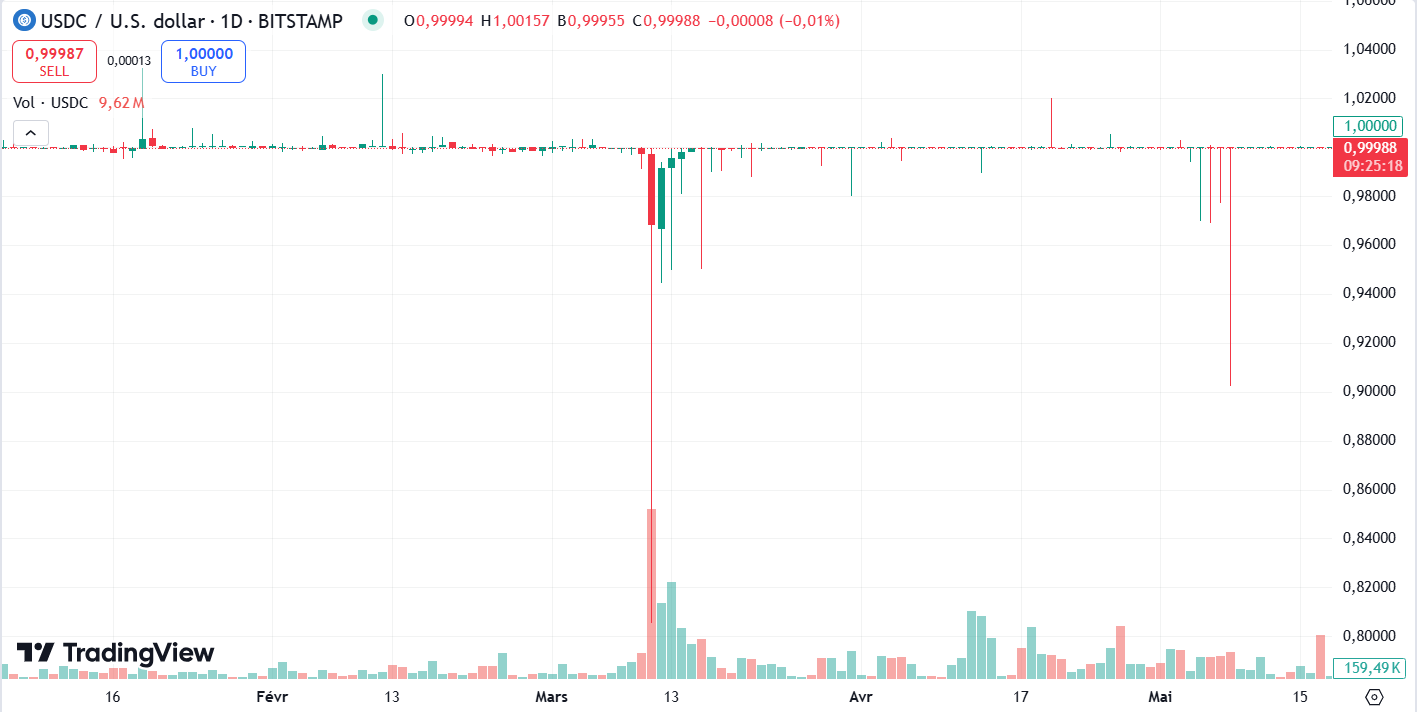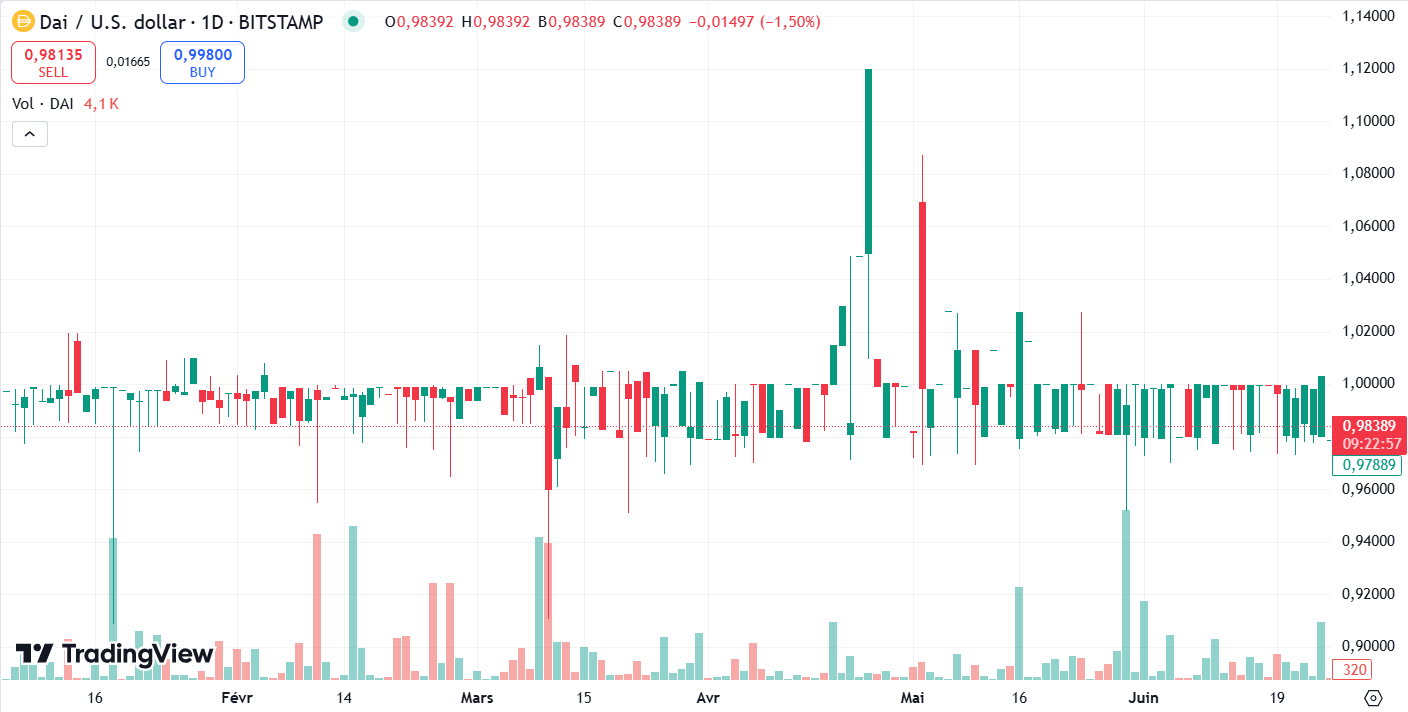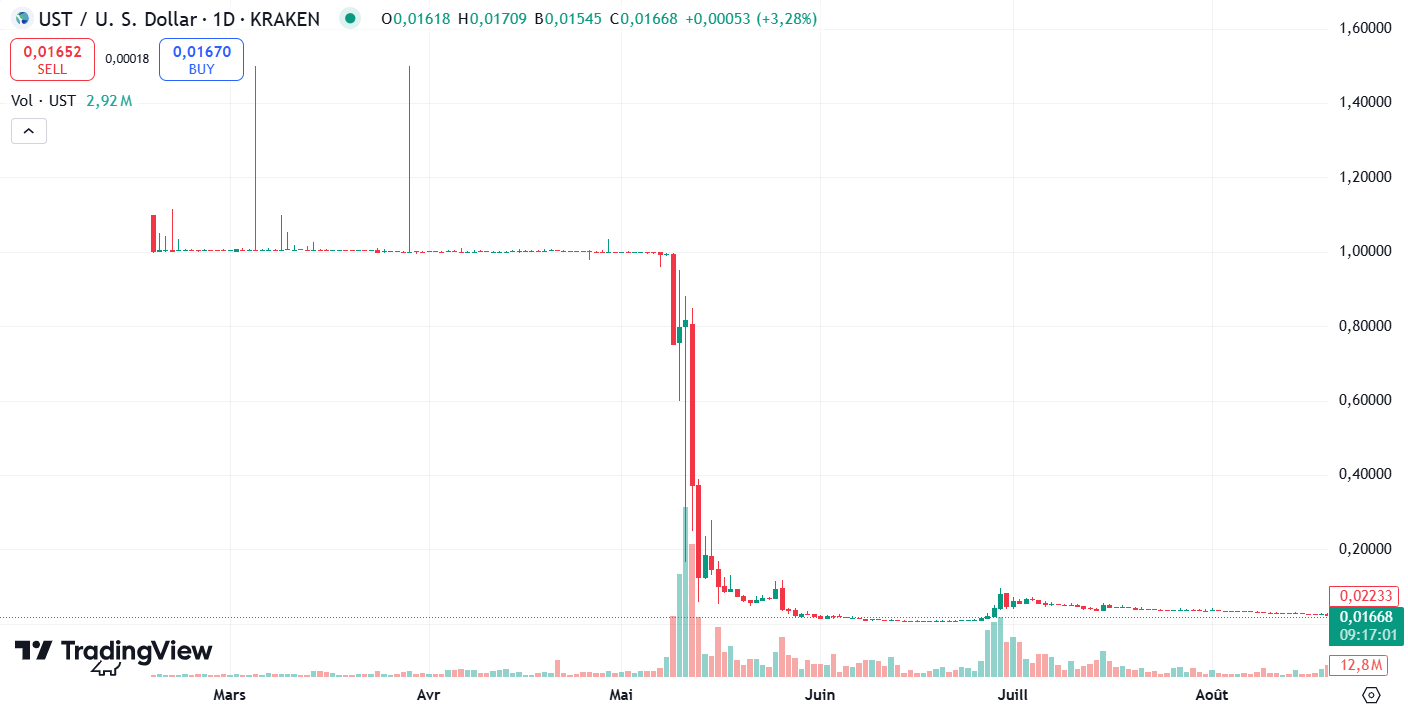What is a Depeg of stablecoin ?
A depeg , in the context of stablecoin , refers to a situation where the value of a stablecoin deviates from its reference price (or "peg"), often pegged to a fiat currency such as the US dollar, the euro, or gold . By definition, these digital assets are designed to offer price stability, making them a central pillar of decentralized finance ( DeFi ). However, a depeg can occur for several reasons, often depending on the type of stablecoin and its operating mechanism.
Table of contents
The bases of a Depeg of stablecoin : what influences the course of a centralized stablecoin ?
stablecoin , such as USDT USDT Tether) or USDC USDC Circle), are designed to maintain a stable value, usually set at $1. This stability relies on physical reserves held by the centralized issuer. These reserves include bank deposits, government bonds, or other traditional financial assets. Each stablecoin in circulation is supposed to be fully backed by an equivalent asset, guaranteeing its nominal value. However, the mechanism that maintains this link relies heavily on the trust of investors and traders in the reserves held .
Maintenance of anchoring thanks to arbitration
The stability of stablecoin s on the secondary market is mainly maintained by arbitration traders which benefit from the differences between the market price of stablecoin and its nominal value of $ 1. This process is based on the confidence that each stablecoin can be exchanged for $ 1 from the transmitter. Here is how this mechanism limits the risks of Depeg :
-
If the stablecoin trades above $ 1 : traders buy the underlying asset (for example dollars ) from the transmitter and sell stablecoin s on the market. This increase in the offer lowers the price of stablecoin until it regains its parity.
-
If the stablecoin falls below $ 1 : the traders buy stablecoin s at a reduced price on the secondary market, then exchange them directly from the transmitter for their nominal value of $ 1. This process reduces the offer on the market and brings the price back to $ 1.
This mechanism is based on the ability of transmitters like Tether or Circle to ensure that stablecoin S can be bought at any time for $ 1 in underlying active ingredients. This implies that traders have total confidence in the solidity and liquidity of the transmitter reserves .
Who can exchange USDT directly for dollars from Tether?
In practice, only major institutional players or verified entities can directly exchange their USDT for dollars with Tether . These exchanges require to go through a process of verification and to respect a minimum redemption threshold, often set at several thousand or million dollars. Individuals cannot directly access this mechanism. They must turn to the secondary markets to buy or sell their stablecoin s. This centralized model means that the confidence of individual traders rests indirectly on the activity of the great arbitration actors , who themselves depend on the ability of TETHER to honor buyouts.
Role of reserves and impact of blocked reserves
The reserves play a central role in order to avoid the Depeg of a stablecoin . . They are used to ensure that a user can exchange their stablecoin for dollars (or other underlying assets) at any time. This link between the quantity of stablecoin in circulation and the assets held in reserve acts as value insurance , encouraging traders to maintain parity.
However, if a significant part of the reserves is blocked or becomes inaccessible (for example, because of a banking bankruptcy or a liquidity problem), this can generate a crisis of confidence . Traders could doubt the transmitter's ability to honor his commitments, which would lead to a massive sale of stablecoin s. This sale for sale would drop their price below $ 1.
Impact of massive sales on the Centralized stablecoin Courses and Depeg
When a crisis of confidence occurs, a massive sale of stablecoins by users can quickly overwhelm the arbitration mechanisms. If the repurchase of redemption exceeds the capacity of the transmitter to provide underlying assets, the price of stablecoin on the secondary market can drop drastically and depeg:
-
Chain effect : arbitration traders, often the first to act, can exhaust the available reserves by buying stablecoin at nominal price. Once these reservations are reached, the transmitter may no longer be able to honor all buy -back requests, aggravating panic.
-
Sustainable disconnection : If investors lose confidence in the issuer's reserves or if they believe that liquidity is insufficient, stablecoin could remain permanently under its parity, or even lose all value, as was observed with certain stablecoin s during past crises.
In conclusion, the course of a stablecoin strongly depends on the confidence of investors in the reserves of the transmitter and in the latter's ability to guarantee a redemption at $ 1. This mechanism, although robust, is vulnerable to trusted crises, to blockages of reserves, and to massive sales, which can cause temporary or prolonged depending ones.
Concrete example:
In March 2023, USDC experienced an excess following the collapse of Silicon Valley Bank, where $ 3.3 billion in its reserves were blocked. This link with banking institutions makes these stablecoin sensitive to traditional financial crises. USDC 's depth , users massively sold their tokens, resulting in temporary drop to $ 0.81. The reassuring announcements of Circle and the support of the American federal reserve made it possible to restore confidence.

What influences the course of a decentralized stablecoin ?
Unlike centralized stablecoin decentralized stablecoin , such as DAI (issued by Makedao), do not rely on reserves held by a centralized transmitter. They are collateralized by cryptocurrencies , often more volatile than bank deposits or obligations. This system is based on smart contract contracts , which manage the creation and redemption of stablecoin overollateralization model . But in case of strong volatility, these mechanisms can show their limits, causing a Depeg .
Maintenance of anchoring thanks to collateralization
The principle is similar to that of stablecoin in the idea of guaranteeing an exchange value equivalent to $ 1. However, in the case of decentralized stablecoin overollateralization of crypto-active :
Creation of stablecoin s: to emit DAI, for example, a user must lock a quantity of cryptocurrency (such as ETH or BTC ) in a smart contract . These assets serve as a guarantee. The value of the assets deposited must generally exceed that of the DAIs emitted (for example, a ratio of 150 %), in order to compensate for the volatility of the collateral.
Affairs and destruction: If a user wishes to recover his collected assets, he must reimburse the exact amount of DAI issued, which is then destroyed. This mechanism makes it possible to control the supply of stablecoin s in circulation and to maintain their anchoring.
Role of overollateralization in confidence
Overollateralization plays a role similar to that of reserves in stablecoin : it guarantees that each DAI in circulation is attached to higher value assets. However, investor confidence is based on the transparency of the protocol and the effective management of guarantees, rather than the solvency of a centralized transmitter.
Concrete example of decentralized Depeg:
In March 2023, the DAI also dropped to $ 0.91 due to its large exposure to theUSDC. Makerdao had to adjust its composition of collaterals to reduce its dependence.

Decentralized stablecoin Depeg risks
However, this model is not flawless. If the value of the collateralized assets drops rapidly (for example, during a market crash), the guarantee can become insufficient, resulting in a risk of Depeg. In these situations, the protocol can force the liquidation of the collateralized positions to maintain stability.
Impact of massive sales on the course
Unlike stablecoin , where a crisis of confidence in reserves can cause a massive sale, the decentralized stablecoin significant fluctuations in the crypto-active market :
Collaboration of guarantees: if the price of collateralized assets falls suddenly, the total value of the guarantees can become less than the value of stablecoin in circulation. This encourages users to sell their DAIs massively (or other stablecoin ), amplifying the downward pressure.
Forced liquidations: To avoid an extent, smart contract can automatically liquidate the sub-collateralized positions, which adds even more pressure on the market and can accentuate volatility.
Comparison with the depeg of centralized stablecoin
Although arbitration traders also play a role in maintaining the anchoring of decentralized stablecoin transparency of the guarantees and the autonomy of smart contract make this model less dependent on confidence in a centralized entity. However, this autonomy has its limits: if the underlying market collapses or if the liquidation mechanisms are ineffective, a stablecoin can lose its anchoring, sometimes prolonged.
In conclusion, the decentralized stablecoin volatility of the crypto-actives used as collateral . In very volatile markets, their model can show flaws, making it a potentially more fragile system than that of the stablecoin centralized in times of significant turbulence.
What influences the course of a stablecoin algorithmic?
The algorithmic stablecoin is distinguished from centralized stablecoin They are based on algorithms and smart contract to maintain their anchoring. Their value is not guaranteed by physical reserves or crypto-active, but by a dynamic system that adjusts supply and demand by emitting or burning tokens. Although attractive for their independence and theoretical scalability, these stablecoin s are particularly vulnerable to trusted crises and volatility which can quickly cause a Depeg.
Maintenance of anchoring thanks to algorithmic mechanisms
The functioning of the algorithmic stablecoin dual model , where stablecoin is generally supported by a governance token or a secondary active ingredient. Take the example of the now famous Terra , which was supported by the Luna :
In the event of an overvaluation (above $ 1): the algorithm emits more stablecoin in circulation, encouraging users to sell them to bring the price to parity.
In the event of an underestimation (below $ 1): the algorithm burns stablecoin s and emits more secondary tokens (like Luna), thus reducing the offer to bring the price to raise.
This system is fully based on user's confidence in the ability of algorithm to maintain balance. If this confidence vacillates, the mechanism can collapse , causing a rapid and severe stablecoin depeg
The critical role of confidence
In algorithmic stablecoin bond of trust is even more fragile than for centralized or decentralized models. As there is no tangible collateral or visible reserves, users must believe that the algorithm will work as expected, even during periods of high volatility. However, this confidence is often put to the test by factors such as:
Turbulent markets: a sudden fall in the market can cause a negative spiral. In the case of the UST, the massive request for redemption led to an excessive destruction of Luna, collapsing its value and aggravating the dependent.
Speculation: These stablecoin s is often used for high -risk strategies, which amplifies their volatility.
Impact of massive sales and algorithmic stablecoin depending
When confidence in a stablecoin algorithmic collapses, massive sales trigger a chain reaction:
Excessive redemption request: users seek to exchange their stablecoin for the secondary token or another asset, putting enormous pressure on the system.
Falling the value of the secondary token: if demand exceeds the capabilities of the algorithm, the secondary token loses its value, further reducing the credibility of the stablecoin .
Liquidation spiral: As we saw with the UST in May 2022, this dynamic can lead to a complete collapse of the stablecoin and the secondary token.
Comparison with the depending on centralized and decentralized stablecoin
Unlike centralized or decentralized models, stablecoin sables have no safety nets in the event of a crisis. Neither physical reserves nor crypto collateral can be mobilized to stabilize their value. This makes them particularly vulnerable to declacing spirals , especially in times of economic stress or intense speculation.
Concrete example of Depeg algorithmic:
In May 2022, the UST de Terra lost its anchoring, causing a catastrophic fall at less than $ 0.01. This collapse also caused the bankruptcy of many linked projects.

MiCA (Markets in Crypto-Astets) regulations , adopted by the European Union, imposes strict requirements on stablecoin s transmitters, in particular the obligation to maintain a liquidity reserve ratio of 1: 1. stablecoin unit must be fully covered by an equivalent active reserve, securely and isolated from the other assets of the transmitter. This requirement for collateralization de facto excludes algorithmic stablecoin , which are based on stabilization mechanisms without reserves of traditional assets. Consequently, the issue of such stablecoin has prohibited under the regulatory framework of MiCA .
This prohibition aims to protect consumers and ensure financial stability by avoiding the risks associated with stabilization mechanisms perceived as more risky and less transparent, characteristics of algorithmic stablecoin.
What lessons for investors?
- Diversify your stablecoin s: Do not bet everything on a single asset, especially in times of uncertainty.
- Look for transparency: favor stablecoin s whose reservations and operation are audited and public.
Conclusion: Depeg risks
stablecoins are essential for the DEFI ecosystem, but they are not without risks. Their extent, whether temporary or permanent, recall the importance of transparency, technological robustness and risk diversification. It remains to be noted that the notable events of Depeg are less and less frequent as the decentralized finance is adopted and that regulations are set up.
Investments in cryptocurrencies are risky. Crypternon could not be held responsible, directly or indirectly, for any damage or loss caused following the use of a property or service put forward in this article. Investments linked to cryptocurrencies are risky by nature, readers must do their own research before undertaking any action and investing only within the limits of their financial capacities. Past performance does not guarantee future results. This article does not constitute an investment .
Certain links of this article are affiliated, which means that if you buy a product or register via these links, we will collect a commission from our partner. These commissions do not train any additional cost for you as a user and certain partnerships allow you to access promotions.
AMF recommendations. There is no guaranteed high yield, a product with high performance potential implies a high risk. This risk taking must be in line with your project, your investment horizon and your ability to lose part of this savings. Do not invest if you are not ready to lose all or part of your capital .
To go further, read our pages legal notices , privacy policy and general conditions of use .

